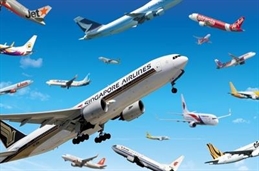
The International Air Transport Association (IATA) reported that global air cargo demand continued to outperform pre-coronavirus levels in May, pointing to a strong growth trend.
In a statement, IATA said global demand, measured in cargo tonne-kilometers (CTKs), during that month was also 9.4% above the levels seen before the Covid-19 pandemic in May 2019.
It said that seasonally adjusted demand rose by 0.4% month-on-month in May, the 13th consecutive month of improvement.
"The pace of growth slowed slightly in May compared to April which saw demand increase 11.3% against pre-COVID-19 levels (April 2019). Notwithstanding, air cargo outperformed global goods trade for the fifth consecutive month," IATA said.
It noted that North American carriers contributed 4.6 percentage points to the 9.4% growth rate in May, while airlines in all other regions except for Latin America also supported the growth.
Capacity remains constrained in May
Meanwhile, IATA said capacity remains constrained in May at 9.7% below pre-Covid-19 levels due to the ongoing grounding of passenger aircraft.
Seasonally adjusted capacity rose 0.8% month-on-month in May, the fourth consecutive month of improvement indicating that the capacity crunch is slowly unwinding.
It noted, however, that underlying economic conditions and favourable supply chain dynamics remain supportive for air cargo.
IATA said the cost-competitiveness of air cargo relative to that of container shipping has also improved. It said pre-crisis, the average price of air cargo was 12 times more expensive than sea shipping. In May 2021 it was six time more expensive.
Trade growth, manufacturing pushes demand up
"Propelled by strong economic growth in trade and manufacturing, demand for air cargo is 9.4% above pre-crisis levels. As economies unlock, we can expect a shift in consumption from goods to services," commented Willie Walsh, IATA's Director General.
"This could slow growth for cargo in general, but improved competitiveness compared to sea shipping should continue to make air cargo a bright spot for airlines while passenger demand struggles with continued border closures and travel restrictions," he added.
IATA noted that Asia-Pacific airlines saw demand for international air cargo increase 5.3% in May 2021 compared to the same month in 2019. This was a decrease compared to the previous month (5.9%) due to a slight slowdown in growth in several large trade routes such as Within Asia.
International capacity also remained constrained in the region, down 16.9% versus May 2019.
It added that for North American carriers, international demand was up 25.5% in May compared to the same month in 2019 — on par with its April performance, and is also the strongest of all regions.
North America leads regional performance
IATA said underlying economic conditions and favorable supply chain dynamics remain supportive for air cargo carriers in North America as the region's international capacity also grew by 1.6%.
European carriers posted an 5.7% increase in demand. This was a decrease in performance compared to the previous month (11.5%) due to a slight slowdown in growth on key trade routes including Europe-Asia and also within Europe.
In the Middle East, IATA said carriers posted a 14.1% rise in international cargo volumes for that month, a slight decrease compared to April (15.6%) — with seasonally adjusted volumes remaining on a robust upward trend.
Latin American carriers reported a decline of 14% in international cargo volumes which IATA noted was the "worst performance of all regions," although it already saw a "significant improvement" compared to the previous month, which saw a 32.3% drop in demand.
African airlines cargo demand in May, meanwhile, increased 24.5% compared to the same month in 2019. IATA said this was a decrease in performance compared to the previous month (34%) which was due to a slowdown in trade flows between Africa and Asia.




